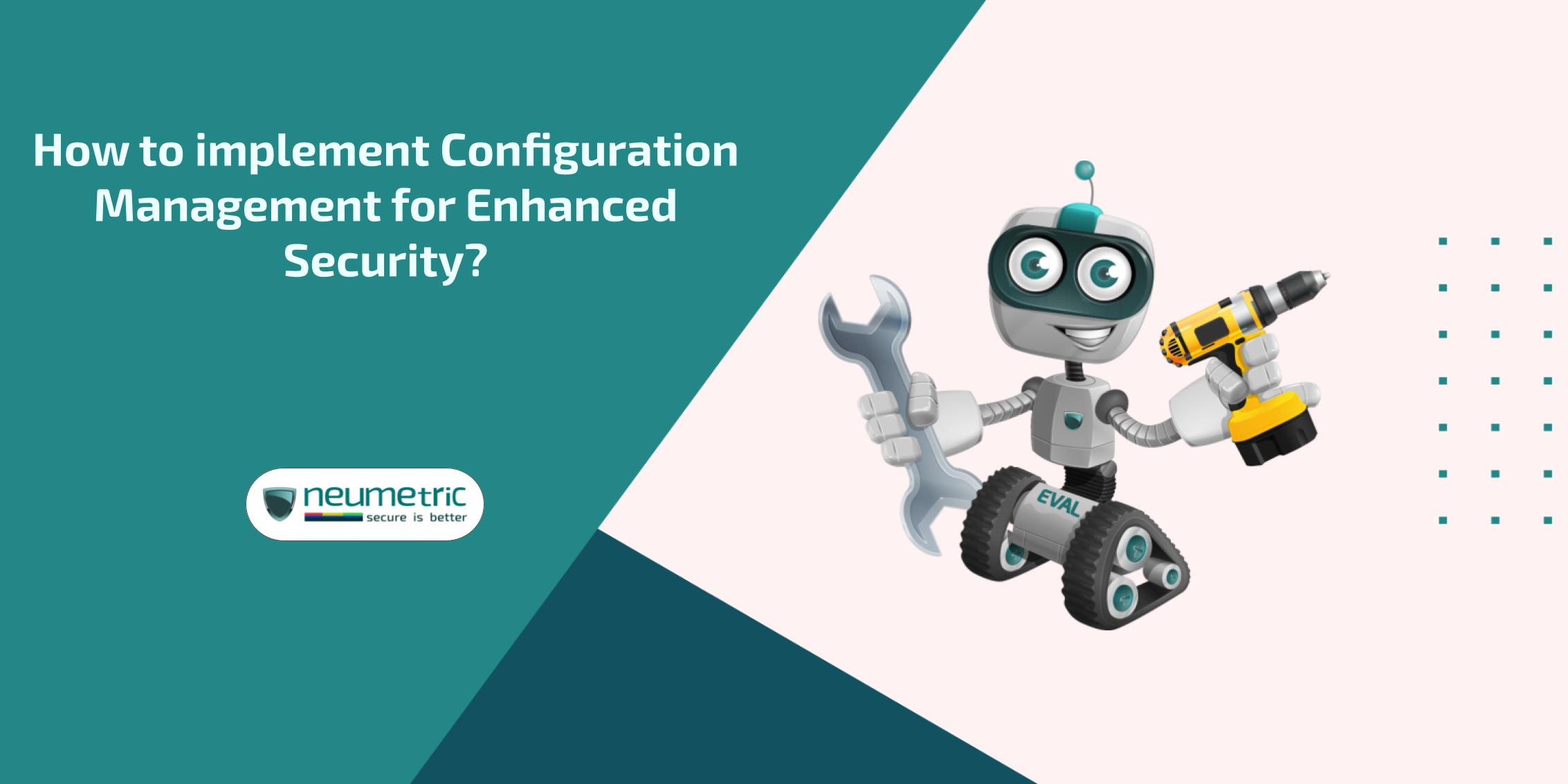Table of Contents
ToggleIntroduction
As systems grow more complex & interconnected, the need for robust security measures has never been more critical. One often overlooked but essential component of a strong security strategy is configuration management. This journal delves into the intricacies of implementing configuration management for enhanced security, providing you with the knowledge & tools to fortify your organization’s defenses.
Understanding Configuration Management
Configuration management is the process of systematically handling changes to a system’s configuration, maintaining its integrity over time. In the context of security, it involves identifying, controlling & verifying the configuration items within an information system. These items can include hardware, software, firmware & documentation.
The primary goal of configuration management is to establish & maintain consistency in a system’s performance, functional attributes & physical attributes throughout its life cycle. By implementing robust configuration management practices, organizations can significantly enhance their security posture, reduce vulnerabilities & improve overall system reliability.
The Importance of Configuration Management in Cybersecurity
In an era where cyber threats are becoming increasingly sophisticated, configuration management plays a pivotal role in maintaining a strong security posture. It’s crucial because proper configuration management helps identify & address potential vulnerabilities before they can be exploited by malicious actors. Many regulatory standards require organizations to implement configuration management practices to ensure data protection & system integrity. In the event of a security breach, well-documented configurations enable faster & more effective incident response. Configuration management provides a structured approach to implementing changes, reducing the risk of security gaps introduced by uncontrolled modifications. It also helps organizations maintain an accurate inventory of their IT assets, ensuring that all systems are accounted for & properly secured.
Key Components of Configuration Management
To implement effective configuration management for enhanced security, organizations should focus on several key components. Configuration identification involves defining & documenting the characteristics of configuration items within a system. This process includes assigning unique identifiers to each configuration item, documenting the relationships between different configuration items & establishing baselines for system configurations. By properly identifying & documenting configurations, organizations can more easily track changes, assess vulnerabilities & maintain consistency across their IT infrastructure.
It involves establishing a change management process, evaluating proposed changes for potential security impacts, implementing approved changes in a controlled manner & documenting all changes made to configuration items. Effective configuration control helps prevent unauthorized or undocumented changes that could introduce security vulnerabilities.
Configuration status accounting involves maintaining records of the current status of all configuration items. It includes tracking the version history of configuration items, documenting the approved configuration baselines & recording any deviations from the approved configurations. Configuration status accounting provides visibility into the state of an organization’s IT infrastructure, enabling faster identification & resolution of security issues.
Regular verification & auditing of configurations are essential to ensure that systems remain in their intended state. This process involves conducting periodic configuration audits, comparing current configurations against approved baselines & identifying & addressing any discrepancies or unauthorized changes. Through consistent verification & auditing, organizations can maintain the integrity of their systems & quickly detect potential security breaches.
Implementing Configuration Management for Enhanced Security
Now that we’ve covered the key components, let’s explore how to implement configuration management effectively to enhance your organization’s security posture. The first step in implementing configuration management is to develop a comprehensive policy that outlines the scope of configuration management within your organization, roles & responsibilities for configuration management activities, procedures for identifying, controlling & verifying configuration items & guidelines for change management & approval processes. A well-defined policy sets the foundation for consistent & effective configuration management practices across the organization.
Based on your policy, develop a detailed plan that outlines how configuration management will be implemented. This plan should include a list of configuration items to be managed, procedures for identifying & documenting configurations, methods for controlling & tracking changes & schedules for configuration audits & reviews. The configuration management plan serves as a roadmap for your organization’s configuration management efforts, ensuring that all aspects are addressed systematically.
Leveraging the right tools can significantly enhance the effectiveness of your configuration management efforts. Consider implementing Configuration Management Databases [CMDB]s to store & manage configuration information, version control systems for tracking changes to software & documentation & automated configuration management tools for continuous monitoring & enforcement of desired configurations. These tools can help streamline configuration management processes & reduce the risk of human error.
Defining baseline configurations for your systems is crucial for maintaining consistency & security. To establish baselines, document the initial, secure configuration of each system, include all relevant security settings & parameters & ensure that baselines align with industry best practices & security standards. Baseline configurations serve as a reference point for future changes & help identify unauthorized modifications.
Effective change control is essential for maintaining the security of your configurations. Implement a change control process that includes a formal change request & approval workflow, security impact assessments for proposed changes, testing procedures to validate changes before implementation & rollback plans in case of unforeseen issues. By controlling changes to your configurations, you can minimize the risk of introducing vulnerabilities or disrupting system functionality.
Periodic audits are crucial for ensuring the ongoing effectiveness of your configuration management efforts. Implement a regular audit schedule that includes comparing current configurations against approved baselines, identifying & investigating any discrepancies, verifying that all changes have been properly documented & approved & assessing the overall effectiveness of your configuration management processes. Regular audits help maintain the integrity of your configurations & provide opportunities for continuous improvement.
Effective configuration management requires the participation of all relevant staff members. Provide comprehensive training on the importance of configuration management for security, your organization’s configuration management policies & procedures, proper use of configuration management tools & processes & the potential security impacts of configuration changes. By educating your staff, you can foster a culture of security awareness & ensure consistent adherence to configuration management practices.
Benefits of Implementing Configuration Management for Enhanced Security
When properly implemented, configuration management can provide numerous security benefits. By maintaining secure baseline configurations & controlling changes, you can minimize the vulnerabilities that attackers can exploit. Configuration management helps ensure that your systems remain compliant with relevant security standards & regulations. Well-documented configurations enable faster identification & resolution of security incidents.
Consistent configurations across your infrastructure lead to improved system stability & performance. By maintaining accurate information about your IT assets, you can more effectively allocate resources for security measures. Comprehensive configuration documentation simplifies the audit process, saving time & resources. In the event of a system failure or breach, well-documented configurations enable faster recovery & restoration of services.
Challenges in Implementing Configuration Management for Security
While the benefits are significant, organizations may face several challenges when implementing configuration management for enhanced security. Large, diverse IT environments can be challenging to manage, requiring significant time & resources to document & control configurations effectively. Staff members may resist new processes or tools, particularly if they perceive them as cumbersome or time-consuming. In rapidly evolving IT environments, maintaining up-to-date configuration information can be challenging.
Overly restrictive configurations may impact system functionality, requiring a careful balance between security & usability. Incorporating configuration management into existing IT & security processes can be complex & may require significant organizational changes. To overcome these challenges, organizations should focus on gradual implementation, continuous improvement & fostering a culture of security awareness among staff.
Best Practices for Configuration Management in Security
To maximize the security benefits of configuration management, consider several best practices.
- Leverage automation tools to streamline configuration management processes & reduce the risk of human error.
- Configure systems & applications with the principle of least privilege, granting users only the permissions necessary for their roles.
- Maintain a robust patching process to ensure that all systems are up-to-date with the latest security fixes.
- Implement continuous monitoring to detect & address any deviations from approved configurations.
- Correlate configuration data with security events to improve threat detection & response.
- Maintain comprehensive documentation of all configurations, changes & procedures to support audits & troubleshooting efforts.
- Periodically review & update your configuration management processes to ensure they remain effective & aligned with your organization’s evolving needs.
By following these best practices, organizations can enhance the effectiveness of their configuration management efforts & strengthen their overall security posture.
Conclusion
In an era of increasing cyber threats, implementing robust configuration management practices is crucial for enhancing organizational security. By systematically identifying, controlling & verifying system configurations, organizations can reduce vulnerabilities, improve compliance & strengthen their overall security posture.
While implementing configuration management for enhanced security may present challenges, the benefits far outweigh the initial investment of time & resources. By following the steps & best practices outlined in this journal, organizations can lay a solid foundation for a more secure & resilient IT infrastructure.
As cyber threats continue to evolve, configuration management will play an increasingly vital role in maintaining strong security defenses. By mastering this essential discipline, organizations can stay one step ahead of potential threats & ensure the ongoing protection of their critical assets & data.
Key Takeaways
- Configuration Management: A critical component of a robust security strategy, essential for maintaining system integrity & reducing vulnerabilities.
- Key Components: Includes identification, control, status accounting, & verification/audit.
- Implementing for Enhanced Security: Involves establishing policies, creating plans, leveraging tools, & conducting regular audits.
- Benefits: Results in a reduced attack surface, improved compliance, enhanced incident response, & increased system reliability.
- Challenges & Solutions: Challenges can be addressed through gradual adoption, automation, & fostering a culture of security awareness.
- Best Practices: Involves automating processes, implementing least privilege, performing regular updates, monitoring for drift, & maintaining comprehensive documentation.
Frequently Asked Questions [FAQ]
How often should we conduct configuration audits?
The frequency of configuration audits depends on various factors, including the size of your organization, the complexity of your IT infrastructure & regulatory requirements. However, as a general guideline, it’s recommended to conduct full configuration audits at least quarterly, with more frequent checks on critical systems. Additionally, implement continuous monitoring tools to detect configuration changes in real-time, allowing for immediate investigation of any unauthorized modifications.
What’s the difference between configuration management & change management?
While closely related, configuration management & change management serve different purposes. Configuration management focuses on identifying, documenting & maintaining the attributes of system components throughout their lifecycle. Change management, on the other hand, is the process of requesting, evaluating, approving & implementing changes to these configurations. In essence, configuration management provides the baseline & structure, while change management governs how that baseline evolves over time.
How can we ensure that our configuration management efforts align with security best practices?
To align configuration management with security best practices, start by referencing industry-standard security frameworks such as NIST, CIS benchmarks or ISO 27001. These provide guidelines for secure configurations across various systems & applications. Additionally, regularly consult with security experts, attend industry conferences & participate in relevant forums to stay updated on the latest security trends & recommendations. Finally, conduct regular security assessments & penetration tests to validate the effectiveness of your configurations in real-world scenarios.
What role does configuration management play in incident response?
Configuration management plays a crucial role in incident response by providing a clear picture of your system’s intended state. When a security incident occurs, having accurate & up-to-date configuration information allows responders to quickly identify any unauthorized changes or anomalies. This information can help pinpoint the source & extent of a breach, guide containment efforts & inform the recovery process. Furthermore, well-documented configurations enable faster system restoration to a known, secure state after an incident has been resolved.
How can we measure the effectiveness of our configuration management program?
Measuring the effectiveness of your configuration management program involves tracking several key metrics. These include configuration accuracy, which is the percentage of systems that match their documented configurations; mean time to detect configuration drift, which measures how quickly unauthorized changes are identified; mean time to correct, which indicates how long it takes to remediate unauthorized changes or vulnerabilities; audit findings, which track the number & severity of issues identified during configuration audits; incident reduction, which measures the decrease in security incidents attributable to configuration-related vulnerabilities; & compliance rate, which represents the percentage of systems meeting required security standards. By monitoring these metrics over time, you can assess the impact of your configuration management efforts & identify areas for improvement. Regular reporting on these metrics to stakeholders can also help demonstrate the value of your configuration management program in enhancing overall security posture.





